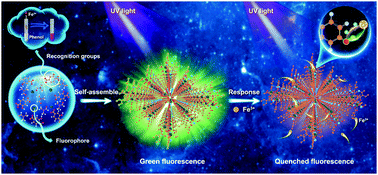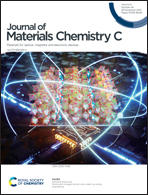An ultra-high quantum yield Tb-MOF with phenolic hydroxyl as the recognition group for a highly selective and sensitive detection of Fe3+†
Abstract
Lanthanide metal–organic frameworks (Ln-MOFs) have been considered as excellent fluorescence materials due to their ability of achieving a tunable fluorescence characteristic. Herein, based on the traditional chromogenic reaction between phenolic hydroxyl groups and Fe3+, a novel luminescent Tb-MOF with high sensitivity and rapid detection of Fe3+ was designed and synthesized using 2-hydroxyterephthalic acid (H2BDC–OH) as the ligand by a facile dripping method. The obtained Tb-MOF possesses a three-dimensional interpenetrating network structure with a myriad of exposed phenolic hydroxyl, which provides abundant active sites for the specific recognition of Fe3+. As expected, the Tb-MOF shows a high sensitivity in the range of 0–100 μM with a low limit of detection (LOD) of 0.35 μM, an excellent selectivity against other interfering metal ions and a rapid response within seconds. The Tb-MOF also achieves an ultra-high quantum yield (QY) of 94.91% because of the good match between the lowest triplet state energy level of H2BDC–OH and the 5D4 energy level of Tb3+, which is verified using density functional theory (DFT) calculations. Moreover, the Tb-MOF realizes a simple and convenient test paper in which the color change can be observed with the naked eye without expensive fluorescence instruments, providing an easy and reliable method for detecting Fe3+ in daily applications. Finally, we proved that the rapid, highly sensitive and selective quenching of Tb-MOF for Fe3+ is due to the specific recognition of the target Fe3+ ions by the plentiful phenolic hydroxyl groups (abundant active sites), as well as the competitive energy adsorption between the ligands and Fe3+. This work lays a solid foundation for designing novel sensing materials to detect target molecules.

- This article is part of the themed collection: Journal of Materials Chemistry C HOT Papers


 Please wait while we load your content...
Please wait while we load your content...